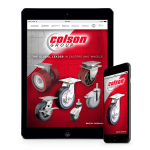COLSON CASTER HEALS HOSPITAL CARTS
A Case Study of Customer Collaboration, Product Engineering, Testing, Delivery, and Service
When hundreds of caster applications on expensive medical carts in several Midwestern hospitals began to fail, the hospitals approached the cart manufacturer for answers. Immediately the cart manufacturer turned to its own caster source for an explanation and a quick solution. What they received instead was a misplaced pride in the original equipment and an unwillingness and resistance to investigate or review the issue, let alone offer a solution. That is when the cart manufacturer located a card left by a regional Colson Caster representative and set up a meeting.
COLSON LISTENED.
Initial talks involved only Colson and the cart manufacturer until it became clear that a greater understanding of the causes of the field failures was needed. At this point, Colson agreed to act as a transparent partner and traveled to join meetings with the hospitals’ own engineering teams. Within this unique circle of engineers, the failures on the series of $3000 to $5000 carts were discussed and documented. With more than 550 of these carts serving three metropolitan hospitals, functioning as 24/7 workhorses, it was critical to identify the issues swiftly and correctly and then institute the best solution.
The carts were all being used in conjunction with the hospitals’ newest work force: a group of robots know as Automated Guide Vehicles (AGV). Working on their own, the carts carried heavy weight loads of items including linens, patient and operational trash and refuse, and full and empty meal trays and shelving. Following their assignments, the AGVs continually transported loaded and empty carts from usage areas to dumping sites and then to cleaning operations and on to resting platforms ready for the next deployment. The robot force collected the carts using a critical slip-through and slide design to ‘scoop’ up the carts from the bottom and rest on their own rolling platform. After emptying, the carts were washed and sanitized and then the robots returned them to a slotted platform for the next deployment.
Colson Collaborated.
The three teams of engineers; the cart manufacturer, the hospitals’ groups, and Colson’s caster engineering experts, working together, determined that the cart wheels were not living up to the needs and demands of the environment. Through discussions and on-site inspections, role-play, and testing, the group came to the consensus that the main issue of the failures was two-fold: following regular usage, the wheels became flat and mushy and, in addition, the full mechanism wobbled, jammed up, and did not slide and scoop when being rolled straight down a hallway or during critical AGV interactions. Both sets of activities had been accurately represented to the cart manufacturer in all proposal specs. With this collaboratively acquired and assessed information in hand, documenting the usage of the carts and now the type of failures being experienced, Colson’s team ‘scooped’ up several new and used carts and returned to its labs for testing.
COLSON TESTED, DESIGNED, AND TESTED AGAIN
Coming to agreement, as a group, as to what the issues were, provided the Colson team the confidence to immediately pursue explanations and determinations as to why the failures were occurring. Upon return to its facilities, Colson’s troubleshooters were able to replicate the functioning environment of the hospitals and the demands of the wheels and carts. Following a sustained series of closely monitored run-throughs, it became apparent that the teams had accurately assessed the failures and that the rigors of the hospital environments were clearly more than the existing caster combination could ever have sustained. Test results were clear that the regular washing of the carts and then drying at temperatures reaching 290 degrees F was the culprit causing the plastic wheels to deteriorate and lose fidelity after each use and cleansing cycle. The caster’s fork and passive swivel design was originally intended to allow straight, non-wobbling functionality and also feature a firm but light-weight swivel disengagement with only 4 pounds of pressure for both human and AGV ease-of-use and mobility.
Testing analysis revealed that upon continued use in the hospitals, the swivel became both hard to disengage, or disengaged when not appropriate with only minimal pressure. This failure in the operation of the fork and swivel mechanism was determined to be resulting from both a lightweight component design weakened by bends in the welds occurring during regular load transport, and from regularly scheduled cleansing cycles. It was also discovered that the cleaning not only removed oil and grease needed for smooth operation and protection of the plastic ball bearing which served as the opening and closing trigger for the entire caster, but also caused structure weakness in the plastic ball bearing itself.
Having identified the failures and successfully determined the causes, Colson proceed to create a comparably priced product for its customer, with improved endurance, to replace the failing cart casters. The Colson solution involved first working on the swivel. For this mechanism the team created a single-piece structure of stainless steel that integrated the lock mechanism with the top plate without welding, and included a steel ball indent mechanism, replacing the old plastic part, to control and maintain the correct swivel pressure levels. This new unit would also save man-hours and money by not requiring the application of oil or grease. The mushy plastic wheels would be replaced in the new caster with a Colson proprietary wheel combination of high-temperature nylon bonded to high-temperature non-marking neoprene, safe and solid in lifetime-drying tests considerably greater than 290 degrees F. In addition, Colson also added twin stainless steel radial bearings to the wheel with high-quality spanners to further stabilize the wheel under the hospitals’ heaviest loads and to further protect the wheel from the constant wash downs.
COLSON DEPLOYED AND FOLLOWED UP
Once the casters were reviewed and it was agreed, by the engineering teams, that a problem-solving solution had been developed, the task came to replace all of the casters on the more than 550 carts within the cart manufacturers’ client operations. In an unprecedented voluntary adventure for Colson staff, a team of manufacturing employees were briefed and trained, and then dispatched to each of the hospital facilities, to not only deliver the new casters, but to install and test as well. This on-site customer service installation of new casters allowed the hospitals to continue functioning with zero down time as the casters were replaced upon cart delivery to the holding racks following their scheduled work day and cleaning. Not only did the onsite installation not interfere with the cart manufacturers’ hospital customers who had already been disrupted by the original faulty casters, but it also gave the Colson team a chance to further screen the improved performance and endurance of the new casters!
Colson’ s commitment to continued improvement has also addressed issues from the field such as maintenance of the grease-free operations of the swivel and the ergonomic values associated with a dual raceway construction. Colson developed, designed, and tested a maintenance free caster for the hospital market with all the features previously noted. The cart manufacturer immediately embraced the design that would now give their hospitals customers a 100% maintenance-free caster assembly, thereby eliminating down time and further potential caster failures. The smooth action of a precision raceway was offered through a stainless steel radial bearing with twin seals. The effortless rotation of the swivel reduced the ergonomic values needed to move a heavily loaded cart. All future carts will contain this new feature, which is another example of working together and listening to the customer to solve concerns.
COLSON AS MONITOR AND PARTNER
Always recognizing the rich rewards of analyzing experiences for lessons, Colson determined along with its new cart manufacturing partner, that the type of on-site testing possible in a working environment such as a busy hospital, is not always a good indicator of the needs dictated by the site. All were in agreement that a series of more rigorous and extreme tests, only possible in an advanced testing lab such as the one operated at Colson, could have discovered the realities of the problem casters before their deployment. This type of testing and engineering is what has always allowed Colson to field caster and wheel products that not only meet, but exceed, the requirements of their partners. In addition, all agreed that in the event that a product should fail upon use, a true partnership and Colson’s customer service standard would involve exploring the situation and finding a solution together. This acknowledgement was soon to be tested…
COLSON’S CONTINUED COLLABORATION
Shortly after Colson’s newly designed caster products had been delivered, installed, and tested in the hospitals, effectively refurbishing the complete installed base of carts, Colson received another order from its new partner. A salesman had just made a large sale of the carts into a new hospital in the same Ohio area. As Colson readied the log and order sheet for manufacture of the new casters for the carts, a subsequent call came in with a question. The sales rep had failed to notice that the entire hospital was carpeted! “Would this make a difference in the type of caster and its requirements?” Colson’s customer service staff immediately analyzed the initial impact of the new information and informed the engineering team to collect their bags and depart for another on-site meeting with its new cart manufacturing partner and their customer’s engineers.







